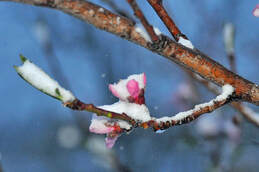
Apricots are more likely to have frost kill flowers than peaches because they bloom a bit earlier. Though there are late-blooming apricot varieties, the differences between full bloom on early and late-blooming varieties appears to be slight. Research at Virginia Tech in the 90's showed a maximum of a 4-day difference between early and late varieties. However, in some years that may be all that is needed. The trees in the study that were considered late blooming included Hungarian Rose, Tilton and Harlayne. Harglow was not included in the study but is also considered late-blooming. See https://tinyurl.com/y35ntxau for more info.
Peaches are next on the list for being likely to be caught by a late frost. With peaches, two characteristics become important when considering whether they will be damaged. Like apricots, bloom time is very important but fruit bud hardiness should also be considered. In this case, fruit bud hardiness refers to hardiness to late frosts rather than the ability to survive extreme low temperatures during the winter. Late bloomers included ‘China Pearl’, ‘Encore’, ‘Intrepid’, and ‘Risingstar.’ See https://tinyurl.com/y35ntxau . The ‘Intrepid’ cultivar also has shown excellent cold hardiness when in flower. See http://www.google.com/patents/USPP12357
So, are there other considerations when looking at possible frost damage? Location can be very important. Planting on a hill which allows cold air to drain to lower elevations can help. Also, a location in town will be more likely to have a warmer micro-climate than an exposed location. Some gardeners will add a heat source under a tree during cold nights if they are close to a building. Heat lamps and charcoal briquettes are sometimes used but safety should be the first consideration. (Ward Upham)
 RSS Feed
RSS Feed
